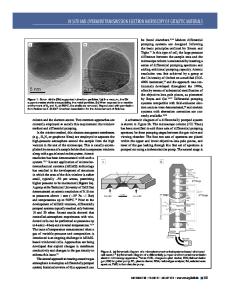In Situ Transmission Electron Microscopy
- PDF / 758,605 Bytes
- 8 Pages / 612 x 792 pts (letter) Page_size
- 96 Downloads / 542 Views
Electron Microscopy
P.J. Ferreira, K. Mitsuishi, and E.A. Stach, Guest Editors Abstract The articles in this issue of MRS Bulletin provide a sample of what is novel and unique in the field of in situ transmission electron microscopy (TEM). The advent of improved cameras and continued developments in electron optics and stage designs have enabled scientists and engineers to enhance the capabilities of previous TEM analyses. Currently, novel in situ experiments observe and record the behavior of materials in various heating, cooling, straining, or growth environments. In situ TEM techniques are invaluable for understanding and characterizing dynamic microstructural changes. They can validate static TEM experiments and inspire new experimental approaches and new theories.
The technique of in situ transmission electron microscopy (TEM) refers to a broad class of experiments whereby the dynamic response of a material to an externally applied stimulus is observed as it happens inside the microscope. Whereas in situ TEM may be one of the most novel but best kept secrets of materials science, the key to its importance lies in something we encounter on a daily basis. The following thought experiment may help make this clear: Imagine looking at two different pictures of a billiard table, taken within five seconds of each other. The first picture shows a white ball and two colored balls on the billiard table. The second picture shows the white ball alone on the table, in a different location than first pictured. If asked to figure out what happened between shots, we might first ask 1) what happened to the colored balls and 2) why is the white ball in a new spot? We might assume a play was made, and the colored balls are in the pockets. However, from the snapshots taken, we see only the outcome and know nothing about the process that led up to it. To know more about the trajectories, the rebounding or angles of play, we would need to observe, in situ (i.e., as the process is happening in real time), the events that took place in the five-second gap between one picture and the next. The ability to observe, film, and record events as they occur in real time is what in situ TEM offers to the world of materi-
als science research. As illustrated in Figure 1, in situ TEM enables real-time observations of structure–property– a
processing relationships, at high magnifications, by employing in situ TEM sample holders, which are essentially no more than small laboratories placed in the column of the microscope. These holders, available commercially or in specific research groups, enable environmental changes to the sample, such as heating, cooling, gas and liquid exposure, straining and indentation, and electrical and magnetic biasing (Table 1). In each of these circumstances, the sample environment is controlled from outside the microscope while the sample is observed and its responses are recorded in real time. From nanoscale observations to biological interactions, advancements in in situ TEM are enabling us to observe the known
Data Loading...











